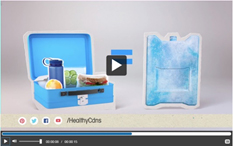Safe school lunches
Getting ready for school can be fun for kids and parents alike. However, along with packing school supplies such as books and pencils, you'll also be packing school lunches for your children. While there are food safety tips that you should follow to avoid food poisoning, it's also important to remember allergy awareness when you are packing lunches. If your children pack their own lunches, you should help them understand how to handle food safely and be aware of food allergies.
On this page:

Health risks
Allergies
Food allergy is a serious illness that affects individuals and families across the country. In Canada, there are over 3 million Canadians who self-report a food allergy, including over 600,000 children. Although many foods can cause allergic reactions, the majority of allergic reactions in Canada are caused by peanuts, tree nuts, sesame seeds, soy, fish, crustaceans and molluscs, wheat, eggs, milk, sulphites and mustard.
Allergens can cause a reaction in your respiratory system, stomach and intestines, skin or cardiovascular system. The symptoms of allergic reactions vary in type and severity, from mild skin irritations and hives to breathing difficulties and loss of consciousness. Symptoms can also develop at different rates, sometimes getting worse very quickly. The most severe reaction, called anaphylaxis, can be fatal. Food allergies are one reason you need to be very careful when packing school lunches for your children.
Food poisoning
Did you know?
You can't tell if food is unsafe by its smell or taste. When in doubt, throw it out!
Food can go unrefrigerated for long periods of time in proper lunch containers, but it is extremely important to keep cold food cold and hot food hot. Food should never reach the temperature danger zone between 4 °C (40 °F) to 60 °C (140 °F) where bacteria can grow quickly and cause food poisoning.
Perishable foods like mayonnaise, tuna salads, chicken salads, egg salads, milk products, cold cuts and other lunch meats are possible targets for the bacteria that cause food poisoning and need to be kept at the right temperature. Any pre-packaged lunch combos containing lunch meats, and cheese also need to be kept cold. Children and young adults can get food poisoning and not even know they have it.
Safety tips for food allergens
Did you know?
You can search recalls and safety alerts by allergen. See "Reason" results on the left-hand column.
Because of the potential seriousness of allergic reactions, many schools have policies in place to stop students from bringing certain items in their lunches. It's very important for you to follow the school's food allergen policy closely, even if your child does not have allergies. The health and safety of other students depends on all parents and students following the school's policies. Here are some tips that can help:
- If your child is allergic to a certain food, make sure the school knows about the allergy. Work with them to come up with a strategy to keep your child safe.
- Remind your child that it is not safe to trade or share food.
- If peanut is on the school policy as a restricted food, try thinking about alternative sandwich-making ingredients. For example, try hummus or apple butter instead of peanut butter.
- Always read the labels on the food you pack in your child's lunch. Don't pack any food with ingredients that are restricted at your school.
- Look for warning statements on the label such as "May Contain...". Remember, even trace amounts can cause a severe allergic reaction.
Safety tips for food
It is extremely important to keep cold food cold and hot food hot, so that your food never reaches the temperature danger zone. Soft, insulated lunch bags or boxes are the best choice for keeping lunches safe. If food should be eaten hot, heat it before your child leaves for school and store it in a heat-preserving container or thermos. To keep food cold, place an ice pack in the lunch bag to keep the food inside cold. You can also freeze an orange, small bottled water or yogurt snack and pack it in the lunch bag or box. Not only will this help keep the lunch cold, but by lunchtime the frozen treat will have melted, giving your child a cold, refreshing water or snack to enjoy with their lunch.
If you will be including fruits and vegetables, remember to wash them thoroughly under fresh, cool, running water, even if they will be peeled.
Some other options to use in school lunches that don't need to stay cold are:
- whole and dried fruits
- cereals
- breads
- crackers
- pickles
- unopened cans of meat and fish
Cleaning your hands, kitchen surfaces, and utensils with hot soapy water is also very important and will help eliminate bacteria and reduce the risk of food poisoning. Always wash lunch bags with hot soapy water after each use. Never reuse sandwich bags, foil and plastic wrap. Remind your children to wash their hands before they eat their lunch and snacks.
How the Government of Canada protects you
The Government of Canada is committed to food safety. Health Canada establishes regulations and standards relating to the safety and nutritional quality of foods sold in Canada. Through inspection and enforcement activities, the Canadian Food Inspection Agency (CFIA) verifies that food sold in Canada meets Health Canada's requirements.
